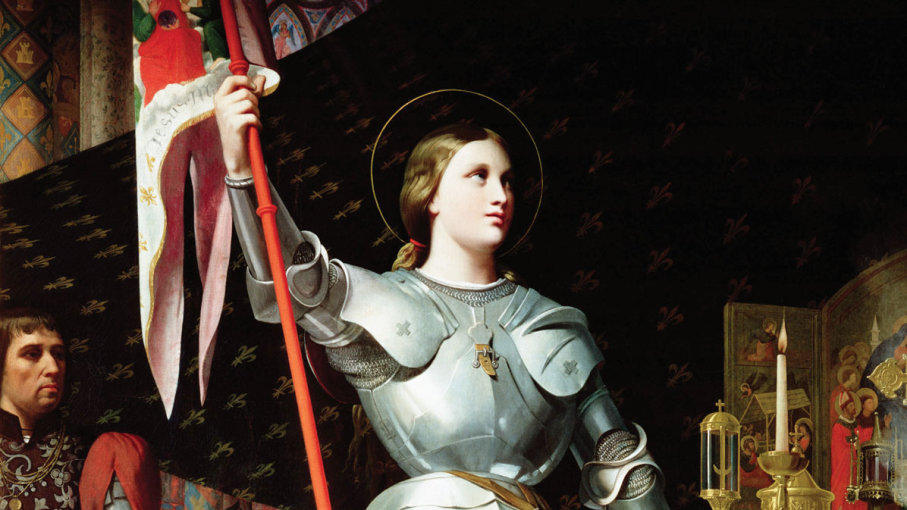Joan of Arc, nicknamed The Maid of Orleans, is considered a heroine of France for her role during the Lancastrian phase of the Hundred Years’ War and was canonized as a Roman Catholic saint. Take a look below for 30 more awesome and interesting facts about Joan of Arc.
1. She was born to Jacques d’Arc and Isabelle Romee, a peasant family, at Domremy in north-east France.
2. Joan said that she received visions of the Archangel Michael, Saint Margaret, and Saint Catherine of Alexandria instructing her to support Charles VII and recover France from English domination late in the Hundred Years’ War.
3. The uncrowned King Charles VII sent Joan to the siege of Orleans as part of a relief mission.
4. She gained prominence after the siege was lifted only nine days later.
5. Several additional swift victories led to Charles VII’s coronation at Reims. The long awaited event raised French morale and paved the way for the final French victory.
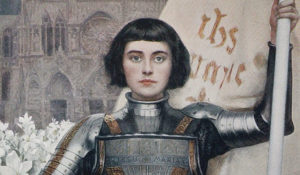
6. On May 23, 1430, Joan was captured at Compiegne by the Burgundian faction, which was allied with the English.
7. She was later handed over to the English and put on trial by the pro-English Bishop of Beauvais Pierre Cauchon on a variety of charges.
8. After Cauchon declared her guilty, she was burned at the stake on May 30, 1431, dying at about 19 years of age.
9. In 1456, an inquisitorial court authorized by Pope Callixtus III examined the trial, debunked the charges against her, pronounced her innocent, and declared her a martyr.
10. In the 16th century, Joan became a symbol of the Catholic League, and in 1803, she was declared a national symbol of France by the decision of Napoleon Bonaparte.
11. She was beatified in 1909 and canonized in 1920. Joan of Arc is one of nine secondary patron saints of France, along with Saint Denis, Saint Martin of Tours, Saint Louis, Saint Michael, Saint Remi, Saint Petronilla, Saint Radegund and Saint Therese of Lisieux.
12. Joan of Arc remained a popular figure in literature, painting, sculpture and other cultural works since the time of her death, and many famous writer, filmmakers and composers have created works about her.
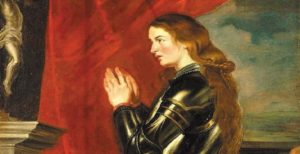
13. Despite being known as a warrior, Joan never actually participated in active combat, and instead worked behind the scenes to outline strategy and direction for French troops as well as lead them into battle.
14. Joan has been posthumously “diagnosed” with disorders ranging from epilepsy to schizophrenia based on the claims that she would often see bright lights and hear voices of angels, saints, and God, instructing her to fight for France.
15. She wasn’t from any place called Arc, but instead from the town of Domremy. Her surname was nothing more than an educated guess as to her father’s surname, which itself shows up in various forms in the extant historical records.
16. Although she didn’t fight, Joan was said to have been injured in battle, at one time allegedly stuck in the chest with an arrow, which she removed herself before resuming her leadership duties.
17. The “bob” style haircut, created in 1909 by a Polish born hairstylist living in Paris, was inspired by Joan of Arc.
18. Joan of Arc was eventually burned at the stake for heresy, not witchcraft, as some sourced claim. It was believed that virgins like Joan were incapable of being witches.
19. After she was burned at the stake, the English cleared the coals to display her charred body, preventing anyone from claiming that she’d somehow escaped. Then, they burned the body twice more to completely obliterate it and prevent anyone from taking any souvenirs.
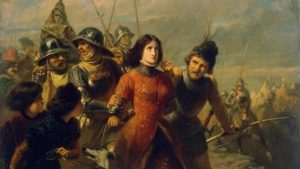
20. After her body was burned to ashes, the remains were thrown into the Seine River, which famously flows through Paris to this day.
21. One of the voices said to have guided Joan was that of St. Catherine, who was herself martyred at the age of 18 more than 1,000 years before Joan would come to follow her. According to Joan, St. Catherine led her to her sword, which was found behind the altar of the church bearing the saint’s name.
22. While she didn’t use her sword to cause harm in battle, it was said that Joan did use her sword to swat away prostitutes who followed soldiers within her camp.
23. Although she couldn’t read, she could sign her name, which she wrote as “Jehanne,” the feminine version of “John,” later translated to “Joan” by the English. Today, in France, she’s known as “Jeanne.”
24. During her trial following her capture by the English, Joan referred to herself only as “Jehanne la Pucelle,” meaning Joan the Maid, and stated on the record that she didn’t even know her last name.
25. As part of a plan devised by her own brothers, several women posed as Joan after her execution and received warm receptions and countless gifts while fooling the people of Orleans.
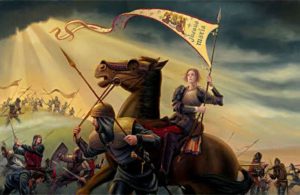
26. Joan of Arc didn’t believe that she was a man, but instead regarded herself as a maiden who wore men’s clothing while carrying out her military duty. Before leading the French in battle, she wasn’t known to have worn men’s clothes.
27. Some sources state that Joan wore male clothing because it was more difficult to tear off and acted as a deterrent against rape.
28. When she was captured by the English in 1430, she signed an admission of guilt on charges of wearing men’s clothing, and claimed that she was contacted by God. Because she was illiterate, many believe that she didn’t actually know what she was signing.
29. At first, she was given a sentence of life imprisonment after singing a confession and removing her men’s clothing. However, she eventually put her men’s clothing back on, in part due to threats of rape by her captors. It was then decided that she would be burned at the stake.
30. St. Bede the Venerable prophesied the arrival of a figure that some believe to be Joan of Arc, speaking of an armed woman who would arrive from the Eastern border of France to liberate the nation.

